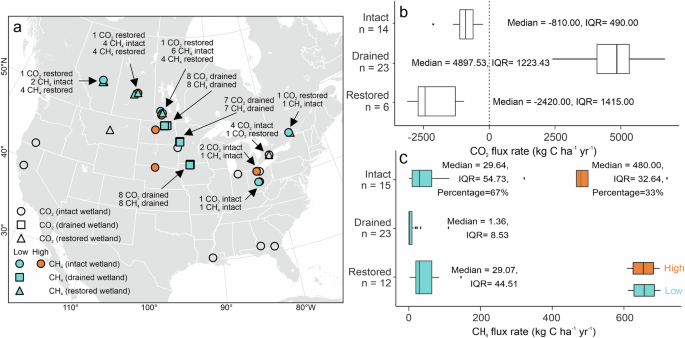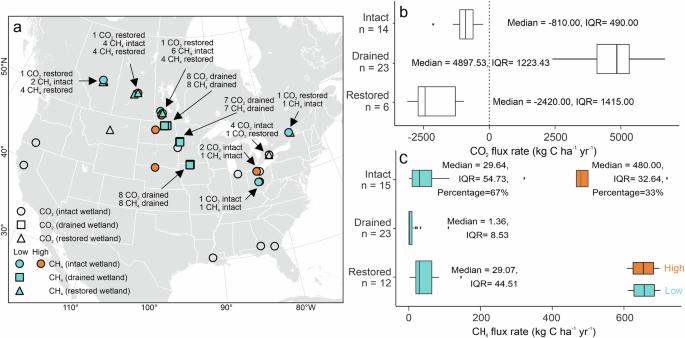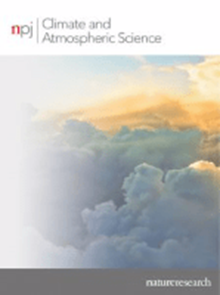New perspectives on temperate inland wetlands as natural climate solutions under different CO2-equivalent metrics
IF 8.5
1区 地球科学
Q1 METEOROLOGY & ATMOSPHERIC SCIENCES
引用次数: 0
Abstract
There is debate about the use of wetlands as natural climate solutions due to their ability to act as a “double-edged sword” with respect to climate impacts by both sequestering CO2 while emitting CH4. Here, we used a process-based greenhouse gas (GHG) perturbation model to simulate wetland radiative forcing and temperature change associated with wetland state conversion over 500 years based on empirical carbon flux measurements, and CO2-equivalent (CO2-e.q.) metrics to assess the net flux of GHGs from wetlands on a comparable basis. Three CO2-e.q. metrics were used to describe the relative radiative impact of CO2 and CH4—the conventional global warming potential (GWP) that looks at pulse GHG emissions over a fixed timeframe, the sustained-flux GWP (SGWP) that looks at sustained GHG emissions over a fixed timeframe, and GWP* that explicitly accounts for changes in the radiative forcing of CH4 over time (initially more potent but then diminishing after about a decade)—against model-derived mean temperature profiles. GWP* most closely estimated the mean temperature profiles associated with net wetland GHG emissions. Using the GWP*, intact wetlands serve as net CO2-e.q. carbon sinks and deliver net cooling effects on the climate. Prioritizing the conservation of intact wetlands is a cost-effective approach with immediate climate benefits that align with the Paris Agreement and the Intergovernmental Panel on Climate Change timeline of net-zero GHG emissions by 2050. Restoration of wetlands also has immediate climate benefits (reduced warming), but with the majority of climate benefits (cooling) occurring over longer timescales, making it an effective short and long-term natural climate solution with additional co-benefits.


不同二氧化碳当量指标下温带内陆湿地作为自然气候解决方案的新视角
由于湿地既能封存二氧化碳,又能排放甲烷(CH4),在气候影响方面是一把 "双刃剑",因此将湿地作为自然气候解决方案的问题一直存在争议。在这里,我们使用了一个基于过程的温室气体(GHG)扰动模型,根据经验碳通量测量值模拟了500年来与湿地状态转换相关的湿地辐射强迫和温度变化,并使用二氧化碳当量(CO2-e.q.)指标在可比的基础上评估了湿地的温室气体净通量。我们使用了三种 CO2-e.q. 指标来描述 CO2 和 CH4 的相对辐射影响--常规全球升温潜能值 (GWP)(考察固定时间范围内的脉冲温室气体排放)、持续通量全球升温潜能值 (SGWP)(考察固定时间范围内的持续温室气体排放)和全球升温潜能值*(明确考虑 CH4 的辐射强迫随时间的变化(最初更强,但大约十年后会减弱))--与模型得出的平均温度曲线相对照。GWP* 对与湿地温室气体净排放相关的平均温度曲线的估计最为接近。利用全球升温潜能值*,完整的湿地可作为二氧化碳当量的净碳汇,并对气候产生净冷却效应。优先保护完好的湿地是一种具有成本效益的方法,可立即带来气候效益,符合《巴黎协定》和政府间气候变化专门委员会到 2050 年实现温室气体净零排放的时间表。恢复湿地也能带来直接的气候效益(减少升温),但大部分气候效益(降温)发生在较长的时间尺度上,使其成为一种有效的短期和长期自然气候解决方案,并带来额外的共同效益。
本文章由计算机程序翻译,如有差异,请以英文原文为准。
求助全文
约1分钟内获得全文
求助全文
来源期刊

npj Climate and Atmospheric Science
Earth and Planetary Sciences-Atmospheric Science
CiteScore
8.80
自引率
3.30%
发文量
87
审稿时长
21 weeks
期刊介绍:
npj Climate and Atmospheric Science is an open-access journal encompassing the relevant physical, chemical, and biological aspects of atmospheric and climate science. The journal places particular emphasis on regional studies that unveil new insights into specific localities, including examinations of local atmospheric composition, such as aerosols.
The range of topics covered by the journal includes climate dynamics, climate variability, weather and climate prediction, climate change, ocean dynamics, weather extremes, air pollution, atmospheric chemistry (including aerosols), the hydrological cycle, and atmosphere–ocean and atmosphere–land interactions. The journal welcomes studies employing a diverse array of methods, including numerical and statistical modeling, the development and application of in situ observational techniques, remote sensing, and the development or evaluation of new reanalyses.
 求助内容:
求助内容: 应助结果提醒方式:
应助结果提醒方式:


